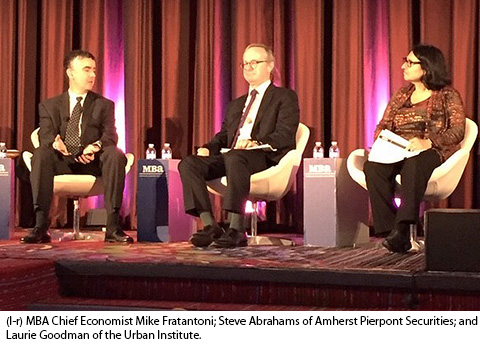
For Secondary Market, Economy a Big ‘What-If’
NEW YORK–Rising inequalities, sluggish growth, political tensions and central bank policy “experimentations” are having their effects on the housing market. Economists here at the Mortgage Bankers Association’s National Secondary Market Conference & Expo said these uncertainties are likely to continue in the next months.
 “The Federal Reserve is the most powerful banking body in the world,” said Mohamed El-Erian, Chief Economic Advisor with Allianz, New York. “And in the past two months, we saw it go from saying there would be two more rate hikes to saying there would be none…understanding why this happened is critical going forward.”
“The Federal Reserve is the most powerful banking body in the world,” said Mohamed El-Erian, Chief Economic Advisor with Allianz, New York. “And in the past two months, we saw it go from saying there would be two more rate hikes to saying there would be none…understanding why this happened is critical going forward.”
El-Erian said one reason could be that policymakers miscalculated data. “The Fed was too confident about the rest of the world and miscalculated the impact of the global economic slowdown. The second reason is more complicated: the data gave us false signals.”
For example, El-Erian noted the recent inversion of the Treasury yield curve, which in the past has signaled an oncoming recession. “That’s not the case today,” he said. “The only thing that’s keeping our rates down is negative rates in Germany…U.S. bonds have become a safe harbor for investors…our yield curve is no longer giving us signals about the U.S. economy-it’s a signal for the global economy.”
A third issue, El-Erian said, is trade, which has become extremely volatile in recent months as the Trump Administration haggles with China and other trade partners. “The Trump Administration has decided that trade is at a disadvantage to the U.S. and China is the problem,” he said. “The Administration has turned the cooperative game into an uncooperative game.”
The initial shock for China and other countries led to retaliation. “The U.S. is going to win a trade war,” El-Erian said. “Other countries, such as Mexico and Canada, made concessions and moved negotiations back to a cooperative gain. That was not the case with China, so it’s very difficult to predict what is going to happen next. And that is leading to genuine uncertainty.”
The fourth factor, El-Erian said, is that basic economic principles are breaking down. “The relationship between employment and inflation is breaking down,” he said. “The models for economic analysis are no longer reliable.”
As a result, economic uncertainties are having an impact on business. “It’s most difficult for mid-sized companies,” El-Erian said. “Technology companies, for example, are either very large or very small. We are living in a world in which the middle is being hollowed out, which is why the world is a harder place to operate.”
Despite this uncertainty, El-Erian said the economy appears to be in no danger of a recession. “The average consumer is in a good place, and they will in turn support the economy,” he said. “Unless the Fed overtightens and unless the trade dispute becomes a global issue, we should not see a recession in the next year or two.”
What you should be worrying about, El-Erian said, is affordability; disruption from below; and emergence of new competitors. “In Silicon Valley, there is talk of ‘entering the second part of the chessboard,'” he said. “What they are telling us is that this combination of market intelligence and Big Data are feeding off of each other. The companies themselves are only starting to understand what they are seeing from good actors and bad actors. And that process is only starting to manifest itself.”
For example, El-Erian said, it took Hilton 100 years to accumulate 800,000 hotel rooms; in its first five years, Airbnb accumulated one million rooms. “Airbnb knows nothing about Hilton’s business plan and it doesn’t care,” he said. “It got where it was by using data and artificial intelligence.”
“You have to be open to disruption,” El-Erian said. “Because you are going to be disrupted, and you’re probably going to be disrupted from somewhere else.”
 At the national level, MBA Chief Economist Mike Fratantoni noted the MBA Economic Forecast sees a stronger purchase market through 2019, buoyed in small part by a “micro-burst” of refinance activity that occurred when rates fell.
At the national level, MBA Chief Economist Mike Fratantoni noted the MBA Economic Forecast sees a stronger purchase market through 2019, buoyed in small part by a “micro-burst” of refinance activity that occurred when rates fell.
“We expect the purchase market to continue to grow and we believe the refi market has found its ‘floor,'” Fratantoni said. “The purchase market is being supported by job growth and Millennial household formation. Beyond 2021, we see continued purchase growth as rates hold fairly steady and job growth continues.”
The current environment is in contrast to expectations last year; Fratantoni said analysts expected the Federal Open Market Committee to continue to raise the federal funds rate and inflation to edge up. “Neither has happened,” he said. “It’s just a structurally different market than we were previously.”
Fratantoni, noted from the 1990s through the financial crisis, new household formation averaged about one million per year. Post-crisis, the recovery has happened, with more than 4.7 million Millennials in prime home-buying age now and more in the offing. “There probably less likely to purchase homes in the exurbs that their parents were willing to do,” he said.
But considerable headwinds persist. Laurie Goodman, Founder and Co-Director of the Housing Finance Policy Center with the Urban Institute, Washington, D.C., said housing supply–or more accurately, lack of housing supply–“is what keeps me up at night.”
“There are 136 million housing units in the U.S.,” Goodman said. “About 826,000 units are obsolete, and there isn’t enough new housing supply taking place to make up for new household formation.”
Since 2009, housing supply creation has not kept up with demand. “And it’s only getting worse going forward,” Goodman said. “The average house in the U.S. was built in 1977–42 years old–and they’re only getting older.”
Complicating matters is the price of land, which has gone up much more than the cost of structure. “Land is becoming more expensive than the building itself,” she said. Add regulatory issues and labor shortages, she said, and the problem becomes more acute.
And the problem is not uniform across the market; Goodman noted home price appreciation is most robust among lower-priced homes. “The reason is that there is so little supply,” she said. “The housing shortage is most acute at the lower end of the market, which is where housing is needed most.” This, she said, results not only in higher starter home prices, but higher rents as well, as people who can’t get into starter housing are forced to rent or stay with their parents, which in turn dampens household formation.
And Steve Abrahams, Senior Managing Director with Amherst Pierpont Securities, New York, noted while lending has improved since the crisis, it has not occurred at the level needed to sustain the market despite increases mortgage credit availability.
“Conventional lending has remained relatively tight,” Abrahams said. “We’ve seen some increases in higher DTI (debt-to-income ratio) lending and in the jumbo market, where lenders have become more borrower-friendly.”
Private-label securitization has grown, Abrahams said, in the non-Qualified Mortgage segment, “partly because the slow surge of credit-worthy borrowers has attracted this kind of funding.”
On credit availability, Goodman said lenders continue to take less half of the credit risk before the financial crisis. “Loans are performing better than ever–documentation takes care of that and automated appraisal models are more accurate,” she said. “But we still are not making the volume of loans that we did pre-crisis.” She added that workers in the gig economy continue to face huge obstacles in getting credit under traditional lending models in which FICO scores are the primary criterion.
Fratantoni noted independent mortgage banks continued to grow their share of mortgage originations, at the expense of depository bank share, in which the number of banks engaged in mortgage lending exit the market.
At the same time, Fratantoni said, profitability as measured by the MBA Performance Reports continues to decline. “It remains a challenging environment,” he said. “It’s not surprising to see a number of banks pulling back from the market. IMBs are increasingly well-positioned to take up the slack.”
